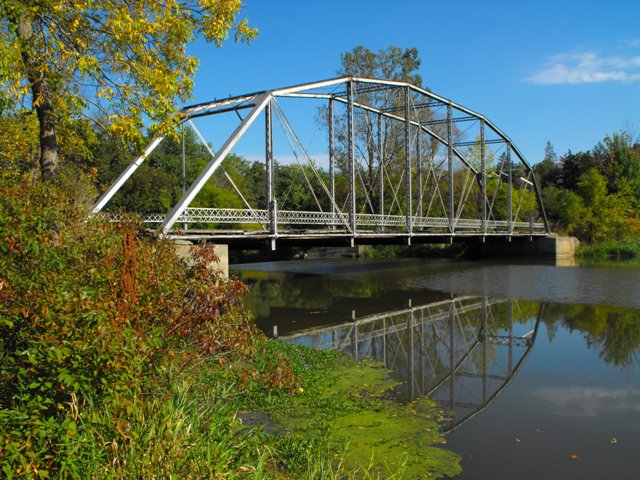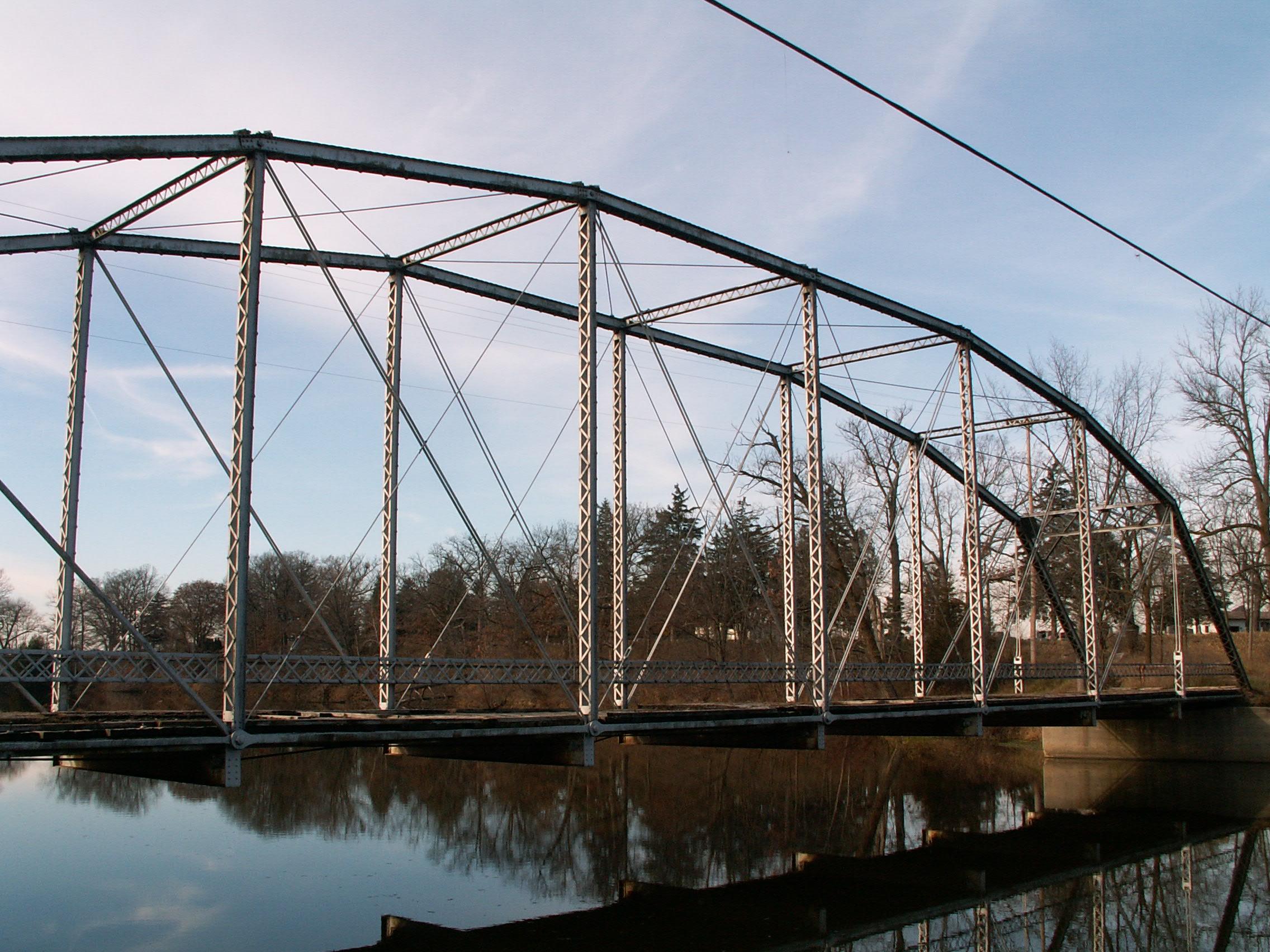We Recommend:
Bach Steel - Experts at historic truss bridge restoration.
BridgeHunter.com Phase 1 is released to the public! - Visit Now
Upton Road Bridge
Grist Mill Bridge

Primary Photographer(s): Nathan Holth and Rick McOmber
Bridge Documented: 2006, September 17, 2010, and March 13, 2021
Elsie: Clinton County, Michigan: United States
1901 By Builder/Contractor: Detroit Bridge and Iron Works of Detroit, Michigan
Not Available or Not Applicable
160.0 Feet (48.8 Meters)
160.0 Feet (48.8 Meters)
16 Feet (4.88 Meters)
1 Main Span(s)
Not Applicable

View Information About HSR Ratings
Bridge Documentation
2021 Update:
View The Historic Bridge Inspection File For This Historic Bridge
View A Website and Facebook Page Dedicated To Saving This Historic Bridge
View The National Register of Historic Places Nomination Form For This Historic Bridge
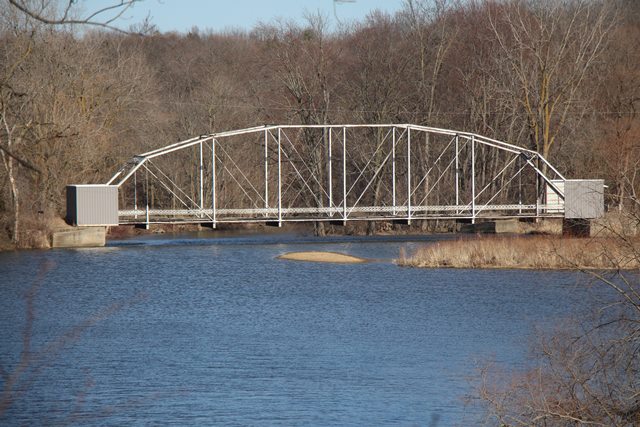
Above: Bridge in 2021 showing how it has been rather aggressively blocked off.
About This Bridge

There are three remaining through Parker truss highway bridges in Michigan, this bridge being one of them. The other two are quite different in design from this one, and are the Turner Road Bridge and the Kent Street Bridge.
This bridge is an eight panel pin connected through Parker truss, located west of the village of Elsie. It crosses the Maple River near a dam, on the reservoir side, the west side, of the dam. The bridge is traditionally composed, and the bridge includes built-up beams with visually pleasing v-lacing, with verticals and struts all v-laced as well as under the top chord. Lattice is present on the portal bracing and also on the original guardrails. This bridge was built in 1901 by the Detroit Bridge and Iron Works. The Imlay City Railroad Bridge was a plate girder also built in 1901 by the Detroit Bridge and Iron Works. The company does not seem to have built many highway bridges, even in its home state of Michigan, and this bridge as such is a rare surviving example of the company's work. The bridge sits on concrete abutments. This bridge is in its original location, and the old road is abandoned although you can see where it once went north of the bridge as it curved west for a short bit before turning and continuing north. The current Upton Road in this area curves westward as it heads south to meet Island Road on the opposite side of the reservoir.
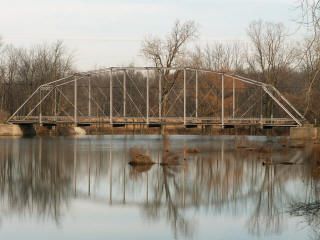
The bridge retains excellent historic integrity, with no major alterations on the bridge at all. Original builder plaques have been stolen, marking the greatest loss to integrity that the bridge has suffered. Overall for a bridge that was closed to traffic and subsequently abandoned, this bridge appears to be in good structural condition, with the exception of its wooden deck which is in poor condition. Located in an undeveloped roadside park setting, restoration of this bridge for non-motorized use seems a sensible option. The bridge is the main attraction for the park, although as it currently stands, the bridge is not being considered as such, and there is even a sign posted warning people to stay off of the bridge.
The traditionally composed truss bridge is configured as follows (approximate measurements accurate/rounded to a half inch): Top chord: back-to-back channels with cover plate and v-lacing, 12 inches wide by 8 inches deep; bottom chord: pairs of up-set eyebars, various sizes including 3 inches and 4 inches wide; vertical members: back-to-back channels with v-lacing on each side, 10 inches by 6 inches; hip vertical members: bottom section composed of back-to-back channels with v-lacing connected to top loop-forged eyebar section by pin connection; diagonal members: pairs of loop-forged eyebars, various sizes including 1 inch and 2 inches; railing: hub guard style, composed of two 2.5 inch wide angles with one row of lattice composed of 1 inch wide bars; floorbeams: rolled American Standard Beam i-beams, 6 inches wide and 18 inches deep; deck support system: rolled American Standard Beam i-beams, 3.5 inches wide and 7 inches deep; deck surface: wooden boards overlaid with wooden blocks with asphalt wearing surface on top; expansion bearings: roller bearing nest, located at north end; abutments: concrete.
The now-missing plaque on the bridge had the following text:
1901
Detroit Bridge & Iron Works
Builders
S. G. Bates Supervisor
E.
V. Chase Clerk
Geo. Craddock Commr.
Preservation Work Assessment
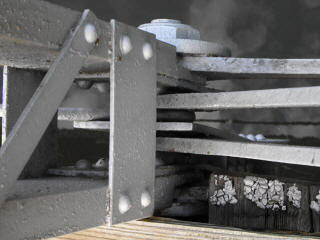
On September 17, 2010, HistoricBridges.org conducted an examination of the Upton Road Bridge to determine the condition of the bridge and to provide insight as to what preservation recommendations were appropriate and what priority they should be given.
Overall the bridge is in surpassingly good condition for a bridge that was closed to traffic and subsequently abandoned. Structurally overall, there are no major problems on the bridge assuming the bridge's use is to stand in an abandoned condition or serve non-motorized traffic. The bridge does not currently appear to be at risk for collapse. In fact, traditional trouble spots on the bridge, particularly the bottom chord connections on the bridge, are in excellent condition.
There are however a few isolated areas of the bridge that are in serious condition and should be addressed in the short term to ensure that these isolated problems do not have a negative impact on the remaining good parts on the majority of the bridge. The good news is that because these are isolated problems, a few low-cost repairs, or even basic maintenance activities that are relatively inexpensive would go a long way to ensuring this bridge remains standing for decades to come.
The worst issues on the bridge are all confined to the bottom ends of the end posts and the bearings.
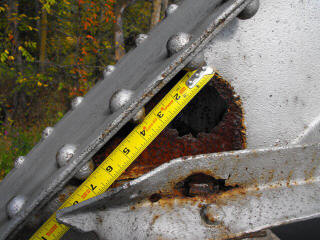
For reasons that are completely unknown, someone long ago jammed some concrete in between the lattice railing and the end post channels. All this did was allow for the entrapment of moisture, which caused rust and section loss. Today, the concrete has fallen away from two of the end posts and remains in place on the other two. Where the concrete fell away, the damage is evident in a circle of 100% section loss on the end post channel. The 100% section loss on the northeast end post was measured to be 3 inches in diameter and with partial section loss included totaled a length of 6 inches along the end post channel. Similar loss is expected on all four end posts. This section loss on the channels makes the endposts more sensitive to buckling forces that might develop on a bridge with frozen expansion bearings, such as the frozen bearing seen on the Upton Road Bridge. Fortunately, the bridge appears to be stable at this time, with no distortion of any bridge members observed. However, this issue could create problems in years to come.
There also is a wad of concrete or asphalt material jammed in between the bottom chord at the southwest corner of the bridge that is causing section loss. This material serves no purpose and if it is not removed, continuing section loss could eventually sever the bottom chord.
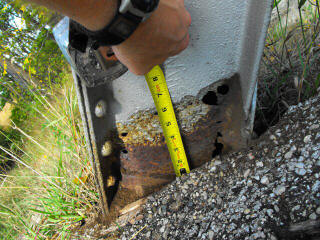
There is significant dirt buildup around the bearings of the bridge, particularly at the north end of the bridge. In particularly, there was no less than a large pile of dirt at the northeast corner of the bridge that has completely buried the bearing, as well as the end of the bottom chord and end post. This appears to have been caused by runoff from the roadway to the north depositing dirt over the years. Simply removing this dirt and cleaning the area out would be beneficial. Dirt buildup freezes the expansion bearings, and will also trap moisture around any of the buried metal, causing section loss. Some of this section loss was observed and measured. Of concern was the section loss again on the end post channel, this time located above a riveted plate near the base of the end post. On the northeast end post, this section loss extended about 6 inches above the riveted plate. On the northwest end post it was noted that a steel plate had been welded to the end post to correct this problem years ago. The repair seems to be holding and working well.
The aforementioned areas of section loss all appear to be on areas that could easily be cleaned and have small plates of steel welded to them, which would correct the section loss. As bridge repairs go, this is about as easy and inexpensive as it gets, and the repairs would go a long way to protecting the bridge. As such, in the short term, these repairs should be given priority.
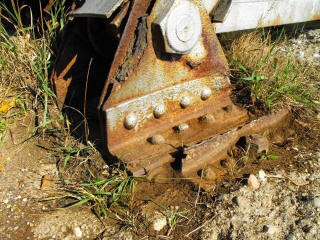
Further, maintained level activities that are simple enough that they could be carried out by volunteers include the removal of dirt around the bearings.
The expansion bearing at the northeast corner of the bridge was buried under a significant amount of dirt and was not observed. The roller bearing nest at the northwest corner was not as heavily buried and was uncovered to reveal it had rolled backward partially off of the masonry plate and now appears to be frozen in that position.
The correction of the bearings and shoe assemblies would be more extensive and costly repairs compared to the plate welding for the end posts, but would be equally valuable in ensuring the continued longevity of the structure. They should be given priority as such.
Finally, in terms of structure, some partial section loss was observed at the base of the vertical members on the bridge. There is also very minor pack rust on the top chord and end post cover plate. There may also be other isolated areas of section loss on the bridge not covered in the HistoricBridges.org examination of the bridge. However these areas do not appear to be in as serious condition as the area at the base of the endposts. In addition, repairs to some of these areas would likely entail a much larger project, more in the line of a full comprehensive restoration. While such a restoration would be highly desirable and very beneficial, they could be given a lower priority in the light of limited funds.
The potential function of the bridge as a crossing for non-motorized traffic, or a place for park users to stand or sit and enjoy the scenery is hindered by the accelerating deterioration of the wooden deck. The deck needs to be replaced. The condition of the metal deck stringers varies in condition. Some of them appeared to be in excellent shape, others had significant section loss on the top flange. Replacement or repair of some of the metal deck stringers may be needed before a new wooden deck would be applied to the bridge. Because the deck is not essential to the existence of the bridge as a historic landmark, HistoricBridges.org suggests these repairs be given a lower priority than the aforementioned structural repairs.
Fortunately for this bridge, the most important part of the bridge's ability to remain standing, its abutments, appear to be in surprisingly excellent condition. There is nearly no spalling or deterioration on any of the above-water portions of the abutments, with the exception of a small area on the northwest abutment corner. The good condition of the abutments may very well be due to the slow rate of water flow around them, which is because the bridge crosses the river at a reservoir, with a dam directly parallel and next to the bridge.
Above: Historical Postcard of Bridge
Source: Donald Harrison, http://www.flickr.com/photos/upnorthmemories/5811365131/, CC BY-NC-ND 2.0
Above: Historical 1910 photo of bridge.
Information and Findings From MDOT
This is one of only three Parker through trusses shown in the Michigan Historic Bridge Inventory. It is the only truss that was clearly produced by the Detroit Bridge and Iron Works, which built very few metal truss bridges in Michigan.
|
This bridge is tagged with the following special condition(s): Unorganized Photos
![]()
Photo Galleries and Videos: Upton Road Bridge
Structure Overview
Original / Full Size PhotosA collection of overview photos that show the bridge as a whole and general areas of the bridge. This gallery offers photos in the highest available resolution and file size in a touch-friendly popup viewer.
Alternatively, Browse Without Using Viewer
![]()
Structure Details
Original / Full Size PhotosA collection of detail photos that document the parts, construction, and condition of the bridge. This gallery offers photos in the highest available resolution and file size in a touch-friendly popup viewer.
Alternatively, Browse Without Using Viewer
![]()
Structure Overview
Mobile Optimized PhotosA collection of overview photos that show the bridge as a whole and general areas of the bridge. This gallery features data-friendly, fast-loading photos in a touch-friendly popup viewer.
Alternatively, Browse Without Using Viewer
![]()
Structure Details
Mobile Optimized PhotosA collection of detail photos that document the parts, construction, and condition of the bridge. This gallery features data-friendly, fast-loading photos in a touch-friendly popup viewer.
Alternatively, Browse Without Using Viewer
![]()
Additional Unorganized Photos
Original / Full Size PhotosA supplemental collection of photos that are from additional visit(s) to the bridge and have not been organized or captioned. This gallery offers photos in the highest available resolution and file size in a touch-friendly popup viewer.
Alternatively, Browse Without Using Viewer
![]()
Additional Unorganized Photos
Mobile Optimized PhotosA supplemental collection of photos that are from additional visit(s) to the bridge and have not been organized or captioned. This gallery features data-friendly, fast-loading photos in a touch-friendly popup viewer.
Alternatively, Browse Without Using Viewer
![]()
Earlier Bridge Photo-Documentation
A collection of overview and detail photos. This photo gallery contains a combination of Original Size photos and Mobile Optimized photos in a touch-friendly popup viewer.Alternatively, Browse Without Using Viewer
![]()
Maps and Links: Upton Road Bridge
Coordinates (Latitude, Longitude):
Search For Additional Bridge Listings:
Bridgehunter.com: View listed bridges within 0.5 miles (0.8 kilometers) of this bridge.
Bridgehunter.com: View listed bridges within 10 miles (16 kilometers) of this bridge.
Additional Maps:
Google Streetview (If Available)
GeoHack (Additional Links and Coordinates)
Apple Maps (Via DuckDuckGo Search)
Apple Maps (Apple devices only)
Android: Open Location In Your Map or GPS App
Flickr Gallery (Find Nearby Photos)
Wikimedia Commons (Find Nearby Photos)
Directions Via Sygic For Android
Directions Via Sygic For iOS and Android Dolphin Browser
USGS National Map (United States Only)
Historical USGS Topo Maps (United States Only)
Historic Aerials (United States Only)
CalTopo Maps (United States Only)



_Maple_River.jpg)
